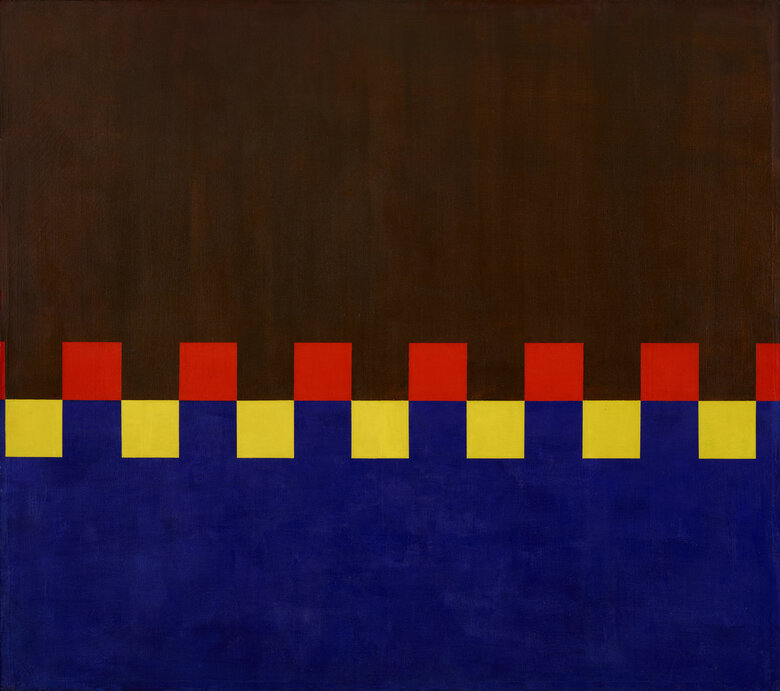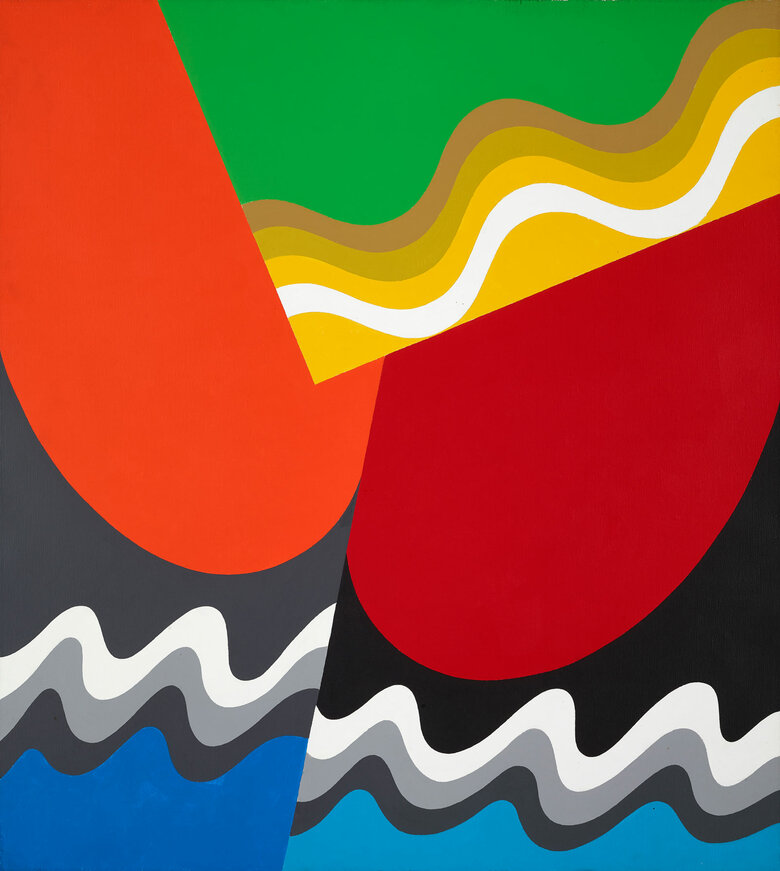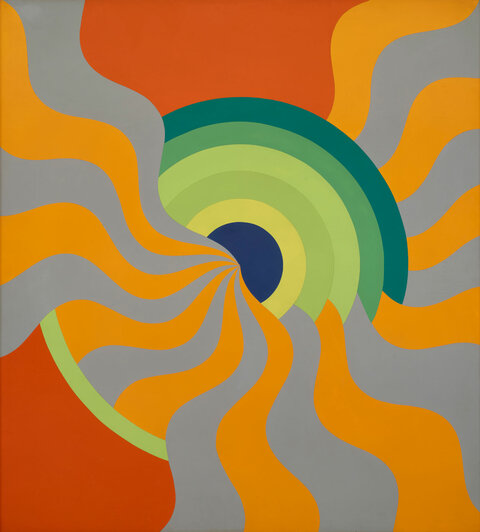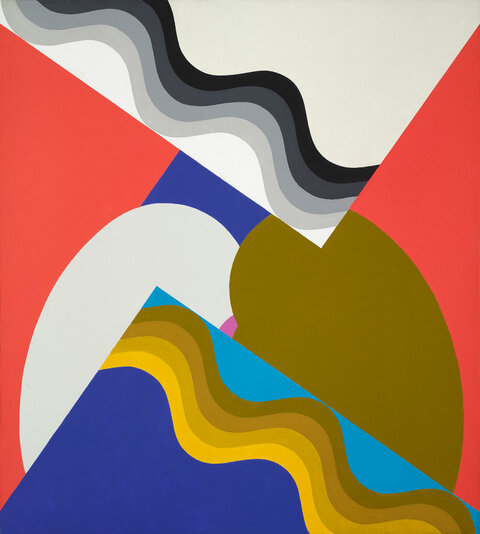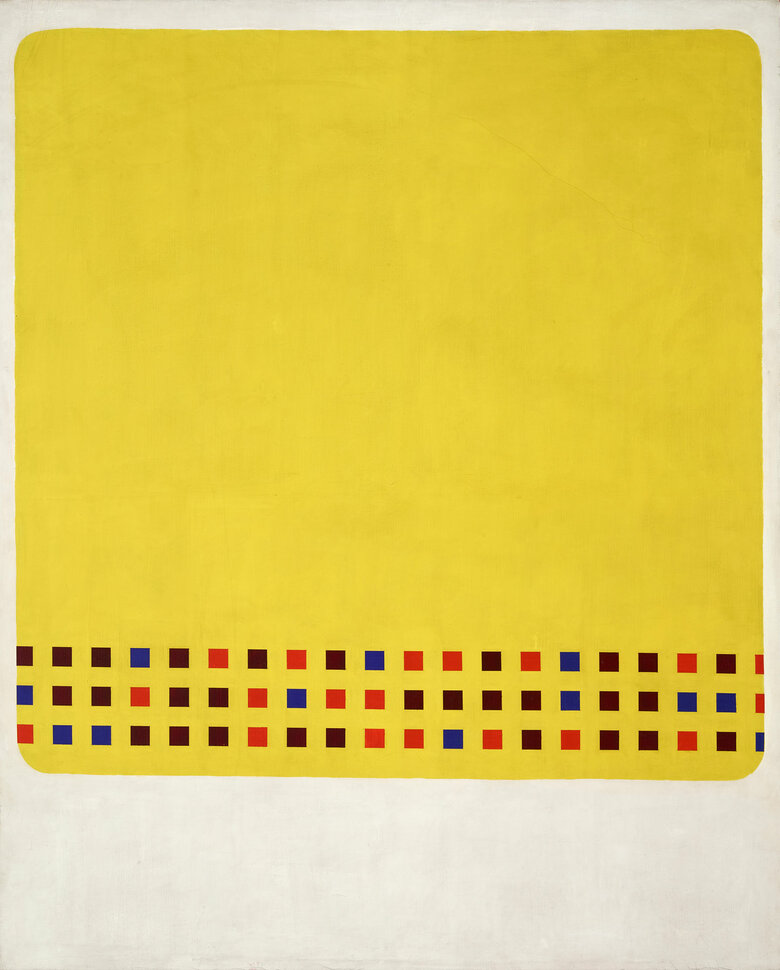Born in the Atlantic coastal city of Asilah in 1936, Morocco, Mohamed Melehi grew up in a cosmopolitan environment, which included people from Spanish, and Sephardic-Jewish communities. This social...
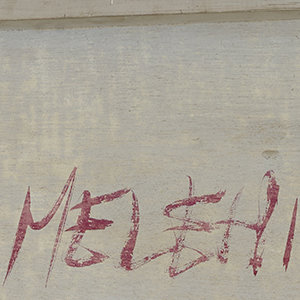

MOHAMED MELEHI, Morocco (1936 - 2020)
Bio
Written by ARTHUR DEBSI
Born in the Atlantic coastal city of Asilah in 1936, Morocco, Mohamed Melehi grew up in a cosmopolitan environment, which included people from Spanish, and Sephardic-Jewish communities. This social diversity made him open to other cultures, religions, and liberties[1]. Despite the expectations of his father, who wished him to become an agricultural engineer[2], Melehi studied at the École des Beaux-Arts in Tétouan from 1953 to 1955. Yet, he had always felt the desire to escape the country, especially when he contemplated the sea, and the boats during his time in Tangiers[3]. He eventually fulfilled his dreams, going to Europe, where he pursued his education in many institutions. In 1955, he enrolled in the Real Academia de Bellas Artes de Santa Isabel de Hungria in Seville, Spain, completing his studies on a scholarship in fine art. The following year, he went to Madrid to study sculpture at the Real Academia de Bellas Artes de San Fernando. Still determined to stay in the continent, he obtained another scholarship, and traveled to Italy in 1957. There, he trained in the department of sculpture in the Accademia di Belle Arti in Rome, for three years. In 1960, he arrived in France, but couldn’t finish the school year at the École Nationale Supérieure des Beaux-Arts in Paris, where he started practicing engraving. Due to the internal context, which stressed the tensions between France and Algeria, Mohamed Melehi didn’t feel comfortable there, and decided to go back to Morocco. However, he quickly left again to go to the United States in 1962, where he became assistant professor in the painting department at the Minneapolis Institute of Art. After one semester, he moved to New York, on a grant from the Rockfeller Foundation, and attended courses in Art History of the 20th century, at Columbia’s University for two years. In 1964, he returned to Morocco for good, and was very active in its new artistic development, that the École des Beaux-Arts in Casablanca stimulated. Thereafter, he played an noteworthy role in publishing: he founded the art, and literary magazine called Intégral in 1972, and co-founded Shoof two years later, a publishing house for artistic, and cultural publications, and cinema productions. Through his career, he also held positions in politics, when he was appointed Head of the Arts at the Ministry of Culture in 1978. The same year, he inaugurated with the Moroccan poet, writer, and journalist Mohamed Benaissa (1937-), the annual Cultural Musim Asilah, in their hometown of Asilah. This event would gather for a month poets, writers, economists, journalists, to discuss a specific subject at the Afro-Arab Forum, an offspring of Cultural Musim Asilah[4]. In 1996, he became advisor to the Cabinet of the Ministry of Cultural Affairs for one year.
The city of Tangiers occupied an important place in Mohamed Melehi’s mind, as it represented a place of freedom, and joie de vivre. He remembered the time when the Spanish troops left the zone in 1945 – after a presence of five years. He saw the blue, red, and white colors of the American, British, and French flags, which replaced the black, and yellow colors of the Spanish, and German ones. Since then, he understood the visual impact of the colors, and the symbolic strength, that they can carry[5].
Through his years of studies, whether in Morocco, or Europe, Mohamed Melehi noticed an academic teaching, which appeared to him to be constraining. And at that time, the student was in search of freedom, and certainly learned more from his personal experiences on the spot. As a matter of fact, he discovered all the riches of culture, art, and history, while visiting prestigious museums, institutions, and galleries. In Italy, he frequented the local artistic circle, and encountered lots of renowned artists from the abstract movement in the mid-20th century, like the painters Carla Accardi (1924-2014), and Giulio Turcato (1912-1995. In parallel, he started exhibiting his works in some galleries, for example at the famous Trastevere Gallery, where he hold his first solo show in 1962. All this time marked the primary step of the artistic journey of Melehi, who furthered his research into abstraction, and work on textures: he would bring with him materials like canvas, wool, and jute from his vacation in Morocco[6]. From 1959 to 1960, he showed an interest in the black color, that he experimented with geometrical shapes, or stripes, on a black background. He wanted to extract light, even if it wasn’t apparent. In New York, the artist moved from a dark palette to the integration of bright colors in his new compositions. The latter are the reflection of his own visual experience, and demonstrated his fascination for the dynamism of the city. Big advertising posters, lights, and jazz music, constituted the urban landscape, which Mohamed Melehi wanted to capture in a series of works. Part of the Dalloul Art Foundation’s collection, the two pieces respectively entitled Zipper (1962), and Time Square (1963), illustrate the observation work of the painter. He imagined light signals like small yellow, and red squares, and insisted on a rigorous symmetric order, giving an electronic aspect to the representations. He somehow referred to the development of technology, and communication, which characterized the era, through which the United States were going during the 1960s[7].
The West did have an effect on Mohamed Melehi’s oeuvre, but the artist sometimes saw himself disconnected to its system, saying: ‘Being Moroccan was, even there, a form of exclusion’[8]. He was aware of his both Muslim, and Moroccan identities, into which he aimed to delve, upon his return to Morocco. When he joined the pedagogical team at the École des Beaux-Arts in Casablanca in 1964, he headed the workshops of painting, sculpting, and photography. In his program, he tended to crossbreed multiple disciplines, namely plastic art, and craftsmanship. Therefore, Mohamed Melehi perfected another method, with his colleagues the Italian art Historian Toni Maraini (1941-), and the Dutchman anthropologist Bert Flint (1931-). Different from a classical teaching, this method proposed to look towards the Moroccan traditional culture, and integrate it in a modern artistic language. The German Bauhaus movement from the beginning of the 20th century was a source of inspiration, because it also promoted the combination of fine arts, and craft[9]. During the courses that he gave, he introduced materials such as rural rugs, and silver jewelry, coming from several regions of the country, so the students could work on them[10].
On May 9th, 1969, Melehi organized an original exhibition in Marrakesh, where a group of artists – mainly from the École des Beaux-Arts in Casablanca – displayed their works in the square, and market place Jemaa el-Fnaa. The objective was to bring art to people, and familiarize them with something that belonged to them, as the group stated: ‘We also wanted to arouse interest in this person, to awaken his curiosity, his critical spirit, to stimulate him so that he integrates new plastic expressions into the rhythm of his daily life, into his daily space’[11]. This event signaled the stage of the independence of Moroccan modern art, affirming its historical, and cultural authenticity. Mohamed Melehi said: ‘Moroccan culture is present; it has developed over the course of centuries. In Morocco, man knew to benefit from all the continental and foreign contributions by integrating them into his own creative genius. In addition, we cannot develop a culture without seeking to identify with a pre-established heritage’[12]. In the process of building a national culture, he asserted the importance of the elaboration of painting, which thoroughly led to the rediscovery of the past.
The oeuvre of Mohamed Melehi is linked to this process, but he is above it all, an experimenter. He is attached to abstraction, and demonstrates a total absence of figuration in his works. However, although coming from a religious family[13], he said that this was not because of religious reasons, but for a more different mindset[14]. As seen in the work called Composition (1976), part of the Dalloul Art Foundation’s collection, he focused on the colors, and the shapes, that are his main experimental ground. He applied bright colors – ‘industrial colors’[15] –, and drew sharp edges, without leaving any brushstrokes on the canvas. He filled the space by interlocking the geometrical forms with each other, like constructions. He created waves that are associated with straight, and broken lines. In some other works such as Untitled (1982), Melehi extended his practice to a symbolic painting. He conveyed the energy forces of the night, by illustrating the moon in the sky, and employing blue nuances. Or, the intensity of what could appear to be the rays of the sun, in Composition (1976), another piece in the DAF’s collection. These ensembles recall the Arabic-Andalusian decor, for example present in the urban architecture, which is based on geometrical order. Here, Mohamed Melehi deconstructed, and re-organized in balance the order of the space, and the forms. The dynamic rhythm that he imposed manifests his innovative approach of abstraction.
Mohamed Melehi worked between Tangiers, and Marrakesh. He passed away in Paris in 2020.
Notes:
[1] Gayet-Descendre, Nadine. ‘Mohamed Melehi, Une Vie’ in Malīḥī Muḥammad, and Pierre Restany. Melehi: Galerie Bab Rouah, Rabat, Du 18 Au 31 décembre 1997. Rabat, Morocco: Galerie Bab Rouah, 1997. [P.37]
[2] Gayet-Descendre, Nadine. ‘Mohamed Melehi, Une Vie’ in Malīḥī Muḥammad, and Pierre Restany. Melehi: Galerie Bab Rouah, Rabat, Du 18 Au 31 décembre 1997. Rabat, Morocco: Galerie Bab Rouah, 1997. [P.39]
[3] Gayet-Descendre, Nadine. ‘Mohamed Melehi, Une Vie’ in Malīḥī Muḥammad, and Pierre Restany. Melehi: Galerie Bab Rouah, Rabat, Du 18 Au 31 décembre 1997. Rabat, Morocco: Galerie Bab Rouah, 1997. [P.40]
[4] Ali, Wijdan. Modern Islamic Art: Development and Continuity. Gainesville, USA: University Press of Florida, 1997. [P.75]
[5] Gayet-Descendre, Nadine. ‘Mohamed Melehi, Une Vie’ in Malīḥī Muḥammad, and Pierre Restany. Melehi: Galerie Bab Rouah, Rabat, Du 18 Au 31 décembre 1997. Rabat, Morocco: Galerie Bab Rouah, 1997. [P.39]
[6] Gayet-Descendre, Nadine. ‘Mohamed Melehi, Une Vie’ in Malīḥī Muḥammad, and Pierre Restany. Melehi: Galerie Bab Rouah, Rabat, Du 18 Au 31 décembre 1997. Rabat, Morocco: Galerie Bab Rouah, 1997. [P.44]
[7] Bergeron, Marie-Anne, and Benjamin Erb. “Vert Le Changement.” Les Dossiers Histoire Et Civilisation,8, no. 1, 2014. [P.32]
[8] Translation from French: ‘Être marocain, restait, même là-bas, une forme d’exclusion’. Mohamed Melehi quoted in Gayet-Descendre, Nadine. ‘Mohamed Melehi, Une Vie’ in Malīḥī Muḥammad, and Pierre Restany. Melehi: Galerie Bab Rouah, Rabat, Du 18 Au 31 décembre 1997. Rabat, Morocco: Galerie Bab Rouah, 1997. [P.49]
[9] Universalis, Encyclopædia. “BAUHAUS.” Encyclopædia Universalis. Accessed June 26, 2020. https://www.universalis.fr/encyclopedie/bauhaus/.
[10] Vlotides, Maria. “Memories - Articles.” bauhaus imaginista. Accessed June 29, 2020. http://www.bauhaus-imaginista.org/articles/13/memories.
[11] ‘Action Plastique : Exposition Jamaa lfna, Marrakech’, Souffles, nos.13/14, 1969, pp.45-46. Translated from French by Emma Ramadan, in Lenssen, Anneka, A. Rogers, Sarah, and Shabout, Nada. Modern Art in the Arab World, Primary Documents. New York, USA: The Museum of Modern Art, 2018. [P.324]
[12] Mohamed Melehi’s response to the Artists’ Questionnaire, Souffles, nos.7/8, 1967 in Lenssen, Anneka, A. Rogers, Sarah, and Shabout, Nada. Modern Art in the Arab World, Primary Documents. New York, USA: The Museum of Modern Art, 2018. [P.278]
[13] Gayet-Descendre, Nadine. ‘Mohamed Melehi, Une Vie’ in Malīḥī Muḥammad, and Pierre Restany. Melehi: Galerie Bab Rouah, Rabat, Du 18 Au 31 décembre 1997. Rabat, Morocco: Galerie Bab Rouah, 1997. [P.37]
[14] Goldenberg, André. “1956 - 1986 : Trente Ans De Peinture Marocaine.” Cahiers De La Méditerranée, 1989. [P.47]
[15] Maraini, Toni. ‘Melehi : un itinéraire d’action, une géométrie visionnaire’ in Malīḥī Muḥammad, and Pierre Restany. Melehi: Galerie Bab Rouah, Rabat, Du 18 Au 31 décembre 1997. Rabat, Morocco: Galerie Bab Rouah, 1997. [P.18]
Sources
Ali, Wijdan. Modern Islamic Art: Development and Continuity. Gainesville, USA: University Press of Florida, 1997.
Adam Jürgen Axel, and Florian Hufnagl. Marokkanische Teppiche Und Die Kunst Der Moderne, Moroccan Carpets and Modern Art. Stuttgart, Germany: Arnoldsche, 2013.
Aroussi, Moulim el., and Brahim Alaoui. Peinture Marocaine 1950-2010: Collection Elisabeth Bauchet-Bouhlal. Marrakech, Morocco: ES-SAADI Garden & Resort, 2010.
Bergeron, Marie-Anne, and Benjamin Erb. “Vert Le Changement.” Les Dossiers Histoire Et Civilisation, 8, no. 1, 2014.
Eigner, Saeb. Art of the Middle-East, Modern and Contemporary Art of the Arab World and Iran. London, UK: Merell Publishers Limited, 2011.
Goldenberg, André. “1956 - 1986 : Trente Ans De Peinture Marocaine.” Cahiers De La Méditerranée, 1989.
Lenssen, Anneka, A. Rogers, Sarah, and Shabout, Nada. Modern Art in the Arab World, Primary Documents. New York, USA: The Museum of Modern Art, 2018.
Malīḥī Muḥammad, and Pierre Restany. Melehi: Galerie Bab Rouah, Rabat, Du 18 Au 31 décembre 1997. Rabat, Morocco: Galerie Bab Rouah, 1997.
“À Propos · School of Casablanca.” School of Casablanca. Accessed June 23, 2020. https://schoolofcasablanca.com/fr/.
Powers, Jean Holiday. “Published.” Casablanca School - Routledge Encyclopedia of Modernism, 2016. https://www.rem.routledge.com/articles/casablanca-school.
Sefrioui, Kenza. “La Revue Souffles (1966-1973): Quand Culture Rime Avec Politique.” Revue Interculturel/Francophonie, (Lecce, Alliance Française, n°16), Ss. Dir. Bernoussi Saltani : "Abdellatif Laâbi : Un Intellectuel Tout Simplement", 2009.
Lakrissa, Fatima Zahra. “École Des Beaux-Arts De Casablanca (1964–1970) - Articles.” bauhaus imaginista. Accessed June 10, 2020. http://www.bauhaus-imaginista.org/articles/2413/e-cole-des-beaux-arts-de-casablanca-1964-1970?0bbf55ceffc3073699d40c945ada9faf=ppq3kadfmlm2tm02ime94tk3q0.
Universalis, Encyclopædia. “BAUHAUS.” Encyclopædia Universalis. Accessed June 26, 2020. https://www.universalis.fr/encyclopedie/bauhaus/.
Vlotides, Maria. “Memories - Articles.” bauhaus imaginista. Accessed June 29, 2020. http://www.bauhaus-imaginista.org/articles/13/memories.
CV
Selected Solo Exhibitions
2024
60 years of creativity... 60 years of innovation, Groupe CDG, Rabatm Morocco
2023
MELEHI SOLO SHOW | MELEHI À LOFT ART GALLERY 2009 - 2020, Loft Art Gallery, Casablanca, Marrakech
2022
MELEHI SOLO SHOW | MELEHI À LOFT ART GALLERY 2009 - 2020, Loft Art Gallery, Casablanca, Marrakech
2021
Contemporary African Art from the permanent collection of the Jordan National Gallery of Fine Arts, The Jordan National Gallery of Fine Arts Amman, Jordan
2020
New Waves: Mohamed Melehi and the Casablanca Art School, Alserkal Art Foundation, Dubai, United Arab Emirates
2019
New Waves: Mohamed Melehi and the Casablanca Art School, Musée d’Art Contemporain Africain – Al-Maaden (MACAAL), Marrakech, Morocco
Melehi, 60 ans de création, 60 ans d’innovation, Espace Expressions CDG, Rabat, Morocco
New Waves: Mohamed Melehi and the Casablanca Art School, The Mosaic Rooms, London, United Kingdom
2017
Mohamed Melehi: 1959-1971, Mathaf: Arab Museum of Modern Art, Doha, Qatar
1997
Galerie Bab Rouah, Rabat, Morocco
1995
Melehi, Institut du Monde Arabe, Paris, France
1984
Melehi, Recent Paintings, Bronx Museum of the Arts, New York, United States of America
1971
Galerie L’Atelier, Rabat, Morocco
1968
Pecamins Gallery, Mexico, Mexico
1965
Galerie Bab Rouah, Rabat, Morocco
1962
Galleria Trastevere, Rome, Italy
1959
Galleria Trastevere, Rome, Italy
1957
American Library, Tangiers, Morocco
Selected Group Exhibitions
2024
AMUR YAKUS, Loft Art Gallery, Casablanca, Marrakech
2022
Taking Shape: Abstraction from the Arab World, 1950-1980s, Herbert F. Johnson Museum, Cornell University, Ithaca, United States of America
Taking Shape: Abstraction from the Arab World, 1950-1980s, Block Museum of Art of Northwestern University, Evanston, United States of America
2021
Feeling the Stones: The First Diriyah Biennial, Al-Diriyah, Riyadh, Saudi Arabia
Taking Shape: Abstraction from the Arab World, 1950-1980s, Tampa Museum of Art, Tampa, United States of America
Group Dynamics, Collectives of the Modernist Period, Lenbachhaus, Munich, Germany
Memory Sews Together Events that hadn’t Previously Met, Sharjah Art Museum, Sharjah, United Arab Emirates
Taking Shape: Abstraction from the Arab World, 1950-1980s, McMullen Museum of Art at Boston College, Boston, United States of America
2020
Les Peintres marocains dans les collections nationales, de Ben Ali R’bati à nos jours, Musée Mohammed VI d’Art Moderne et Contemporain, Rabat, Morocco
2018
A Century in Flux, Highlights from the Barjeel Art Foundation, Sharjah Art Museum, Sharjah, United Arab Emirates
2017
E-Mois, Autobiographie d’une collection, Musée d’Art Contemporain Africain – Al-Maaden(MACAAL), Marrakech, Morocco
2016
The Sea Suspended, Tehran Museum of Contemporary Art, Tehran, Iran
Postwar: Art between the Pacific and the Atlantic 1945-1965, Haus der Kunst, Munich, Germany
The Short Century, Sharjah Museum, Sharjah, United Arab Emirates
2015
Le Maroc Contemporain, Insitut du Monde Arabe, Paris, France
2014
Sky Over the East, Emirates Palace, Abu Dhabi, United Arab Emirates
1914-2012: 100 ans de création, Musée Mohammed VI d’Art Moderne et Contemporain, Rabat, Morocco
2013
Modernités Plurielles, Centre Georges Pompidou, Paris, France
Un Été pour Matisse, Musée d’Art Moderne et d’Art Contemporain, Nice, France
2007
Art Contemporain Arabe, Palais de la culture Moufdi-Zakaria, Algiers, Algeria
1989
Peintres Marocains, Centra de Cultura Contemporánea Conde Duque, Madrid, Spain
1988
Peinture Contemporaine au Maroc, Musée des Beaux-Arts d’Ixelles, Brussels, Belgium
1987
The 19th São Paulo Biennial, São Paulo, Brazil
1985
19 Peintres du Maroc, Centre National d’Art Contemporain de Grenoble, Grenoble, France
1980
Art Contemporain du Maroc, Fundació Joan Miró, Barcelona, Spain
1978
First International Cultural Moussem, Asilah, Morocco
1976
The 2nd Arab Biennial, Oudayas, Rabat, Morocco
1975
Palestine, Galerie Bab Rouah, Rabat, Morocco
1974
The 1st Arab Biennial, Baghdad, Iraq
1972
Festival Al-Wasiti, Baghdad, Iraq
1969
Présence Plastique, Place du 16 Novembre, Casablanca, Morocco
Présence Plastique, Jemaa El-Fna, Marrakech, Morocco
1966
Festival International des Arts Nègres, Dakar, Senegal
Group exhibition with Farid Belkahia, Mohammed Chebaa, Hall du Théatre Mohammed V, Rabat, Morocco
1963
Hard Edge and Geometric Painting and Sculpture in New York, MoMa, New York, United States of America
Formalists: from Mondrian to Kelly, National Gallery of Art, Washington D.C., United States of America
Rencontre Internationale des Artistes, Musée des Oudayas, Rabat, Morocco
1961
The 2nd Biennale des Jeunes, Paris, France
1959
The 1st Biennale des Jeunes, Paris, France
Honors and Awards
2008
Order of Merit by HRH Mohammed VI
1989
Aga Khan Award for Architecture for the rehabilitation of Asilah overseen by Association Culturelle Al-Mouhit, Cairo
Affiliations and Memberships
1978
Association Culturelle Al-Mouhit
2008-
2020
President of the Association Marocaine des Arts Plastiques
1976-
1982
President of the Association Marocaine des Arts Plastiques
1961
The Casablanca Art School
Collections
Centre Georges Pompidou, Paris, France
Institut du Monde Arabe, Paris, France
Mathaf: Arab Museum of Modern Art, Doha, Qatar
Musée d’Art Contemporain Africain – Al-Maaden (MACAAL), Marrakech, Morocco
Musée Mohammed VI d’Art Moderne et Contemporain, Rabat, Morocco
Tate Modern, London, United Kingdom
The Ramzi and Saeda Dalloul Art Foundation, Beirut, Lebanon
Documents
MOHAMED MELEHI EXPOSE « SIMILITUDE » À LOFT ART GALLERY
La Rédaction
www.femmesdumaroc.com, French, 2017
Press
THE CASABLANCA ART SCHOOL | SHARJAH ART FOUNDATION
www.loftartgallery.net, English, 2024
Arab Presences: Modern Art And Decolonisation: Paris 1908-1988
www.mutualart.com, English, 2024
Musée d'Art Moderne de Paris
Modern and Contemporary Art of the Arab World
www.mutualart.com, English, 2023
Christie’s London
The Casablanca Art School
www.mutualart.com, English, 2023
A major exhibition about the artists of the renowned Casablanca Art School.
THE CASABLANCA ART SCHOOL | SHARJAH ART FOUNDATION
www.loftartgallery.net, English, 2023
فنان و مكان.. محمد المليحي و أصيلة
سعيد بوكرامي
alarabiya.net, Arabic, 2022
موسوعة متحف للفن الحديث والعالم العربي: محمد ملحي
ھولیدي باورز
mathaf.org.qa, Arabic, 2022
سیرة الفنان
ART DUBAI
www.loftartgallery.net, English, 2022
Mohamed Melehi - Malika Agueznay - Marion Boehm - Mous Lamrabat - Mohamed Lekleti
6 new art exhibitions to see in Dubai this autumn: from unseen Mohamed Melehi works to reflections on Indian history
TheNational.ae, English, 2020
670 Moroccan Artists Express Trust in Institutions, Denounce ‘Hostile’ Petition
Taha Mebtoul
www.moroccoworldnews.com, English, 2020
Many of the petitioners fought to advance human rights in Morocco during the country’s “years of lead.”
Alserkal Lates a sign of what to expect as UAE cultural events return: 'It's not you, it's Covid-19'
Alexandra Chaves
www.thenationalnews.com, English, 2020
One of the first art events featuring large gatherings in the UAE, Alserkal Lates signals a desire for a cultural comeback
Mohamed Melehi, Moroccan Modernist Whose Influence Loomed Large, Has Died at 84 of Covid-19
Alex Greenberger
www.artnews.com, English, 2020
En pleine pandémie, une oeuvre de Mohamed Melehi bat tous les records aux enchères à Londres
www.libe.ma, French, 2020
Welcome Home Vol. II
www.mutualart.com, English, 2020
MACAAL, Museum of African Contemporary Art Al Maaden
الرسام محمد المليحي جدد الفن المغربي بحركة الأمواج
عبد الرحيم الخصار
www.independentarabia.com, Arabic, 2020
وباء كورونا أنهى حياة التشكيلي الرائد والمثقف وصديق الشعراء وأحد مؤسسي مهرجان أصيلة
Mohamed Melehi, figure de proue de l’art contemporain marocain, est mort
Roxana Azimi
www.lemonde.fr, French, 2020
Le peintre est décédé mercredi 28 octobre à Paris des suites du Covid-19.
Upsurge: Waves, Colour and Illusion
www.mutualart.com, English, 2020
Lawrie Shabibi
Announcing awardees of inaugural research grants, Mohamed Melehi exhibition, and digital programming
www.e-flux.com, English, 2020
محمد الملیحي.. سیرة فنان نسج الوجود - لوحة ورحل
أشرف الحساني
www.aljazeera.net, Arabic, 2020
Mohammed Melehi, Morocco’s Modern Art Master
www.moroccotravelblog.com, English, 2019
New Waves: Mohamed Melehi and the Casablanca Art School
www.selectionarts.com, English, 2019
Give us a swirl: How Mohamed Melehi became Morocco's modernist master
oliver Basciano
www.theguardian.com, English, 2019
Mohamed Melehi, le dernier des grands pionniers
telquel.ma, French, 2019
أمواج جديدة: كيف شكل الفنان المغربي محمد المليحي جمالياته
www.al-fanarmedia.org, Arabic, 2019
الفنان التشكيلي المغربي محمد ملهي: تموجات جمالية
altshkeely.brinkster.net, Arabic, 2017
محمد المليحي يعرض مسارات الألوان والأشكال والضوء بالبيضاء
خالد لمنوري
maghress.com, Arabic, 2017
محمد المليحي: رسام الكنوز التي يلقيها البحر على الشاط
فاروق يوسف
alarab.co.uk, Arabic, 2014
Arts plastiques : Mohammed Melehi, peintre en transhumance
www.leconomiste.com, French, 1995
الفنان التشكيلي محمد المليحي من التشكيل بموج التجريد المحلي إلى العالمية _ صحيفة روناهي.pdf
محمد الأمين المليحي.. سيرة فنان وتجليات مدينة _ الجزيرة نت.pdf
The eye and hand of Mohamed Melehi _ Art Basel.pdf
Morocco’s Loft Art Gallery to make its debut at Art Basel Paris.pdf
محمد مليحي_ عملاق فن ما بعد الاستعمار في المغرب - Qatar Museums.pdf
فنان ومكان.. محمد المليحي وأصيلة.pdf
Videos
MOHAMED MELEHI Artwork
Become a Member
Join us in our endless discovery of modern and contemporary Arab art
Become a Member
Get updates from DAF
Follow Artists
Save your favourite Artworks
Share your perspectives on Artworks
Be part of our community
It's Free!
We value your privacy
TermsCookiesPrivacy Policies
Become a Member
Get updates from DAF
Follow Artists
Save your favourite Artworks
Share your perspectives on Artworks
Be part of our community
It's Free!
We value your privacy
TermsCookiesPrivacy Policies
Become a Member
Get updates from DAF
Follow Artists
Save your favourite Artworks
Share your perspectives on Artworks
Be part of our community
It's Free!
We value your privacy
TermsCookiesPrivacy Policies
Welcome to the Dalloul Art Foundation
Thank you for joining our community
If you have entered your email to become a member of the Dalloul Art Foundation, please click the button below to confirm your email and agree to our Terms, Cookie & Privacy policies.
We value your privacy, see how
Become a Member
Get updates from DAF
Follow Artists
Save your favourite Artworks
Share your perspectives on Artworks
Be part of our community
It's Free!
We value your privacy
TermsCookiesPrivacy Policies

-Front.jpg)
-Front.jpg)
